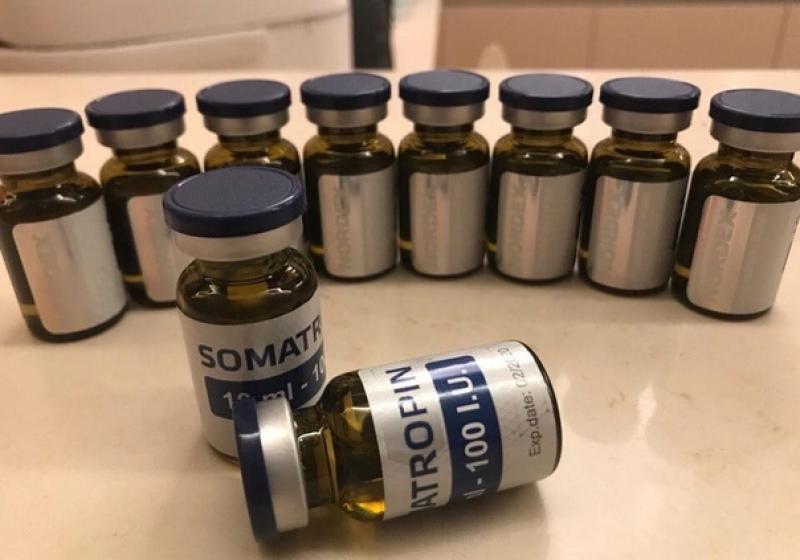What is Somatropin?
Somatropin, commonly known as human growth hormone (HGH), is a peptide hormone that stimulates growth, cell reproduction, and cell regeneration in humans and other animals. It is produced by the pituitary gland and promotes growth of osteoblasts and chondrocytes and stimulates protein synthesis in muscle and other tissues.
Function and Mechanism of Action
As the name suggests, the primary function of it is to stimulate growth in children and adolescents. It also aids the process of cell reproduction and regeneration in adults. Here is a brief overview of its functions and mechanism of action:
- Promotes longitudinal bone growth: It stimulates the proliferation and differentiation of chondrocytes, the cartilage cells responsible for longitudinal bone growth. This helps in linear growth until epiphyseal fusion occurs during puberty.
- Increases muscle mass: It stimulates protein synthesis in muscle tissues and inhibits protein breakdown. This results in increased muscle mass and strength.
- Boosts liver function: The liver is one of the major target organs of somatropin. It stimulates glycogenolysis and gluconeogenesis in the liver, thereby increasing blood glucose levels.
- Regulates body composition: Somatropin increases lean body mass and reduces body fat percentage. It stimulates lipolysis, the breakdown of triglycerides into fatty acids.
- Promotes cell regeneration: It helps in repairing and regenerating various tissues and cells in the body, including renewal of skin and organs.
- Regulates metabolism: It stimulates breakdown of fat and increases oxygen uptake by tissues. This helps in regulation of metabolic activities and energy balance.
- Aids collagen synthesis: It stimulates the production of various connective tissue proteins like collagen. This provides structural integrity to bones, skin, muscles, etc.
At the molecular level, somatropin exerts its growth-promoting and metabolic effects by binding to growth hormone receptors on target cells. This triggers intracellular signaling cascades like JAK-STAT and MAPK pathways. These pathways ultimately upregulate genes involved in proliferation, anabolism and protein synthesis.
Uses
Growth hormone deficiency treatment
Replacement therapy with it is widely used for the treatment of growth hormone deficiency in children and adults. This helps stimulate longitudinal bone growth and restore near-normal growth patterns and attain adult height potential in children with GHD. In adults, it aids rebuild of lean muscle mass and bone mineral density.
Wound healing
Several studies have shown that its treatment improves wound healing through stimulation of collagen synthesis, angiogenesis and re-epithelialization. This property is utilized for treatment of slow-healing wounds and burns.
Aging and anti-aging
Loss of somatotropic function contributes to age-related declines like decreased muscle mass, bone density and impaired metabolism. Supplemental somatropin therapy helps mitigate some aspects of biological aging by increasing lean body mass and physical performance in elderly individuals.
Bodybuilding
Anabolic properties of it make it a popular performance-enhancing drug among bodybuilders and athletes. However, its use for bodybuilding is considered unsafe and illegal without medical supervision due to risk of adverse effects.
Side Effects and Safety Concerns
Like any drug therapy, its replacement also carries risks if not administered judiciously under medical guidance. Some common side effects seen with somatropin supplementation include:
- Fluid retention: Risk of edema, carpal tunnel syndrome, joint pain due to water retention.
- Hyperglycemia: Risk of impaired glucose tolerance or diabetes due to increased blood sugar levels.
- Arthritis/joint pain: Increased risk due to growth of soft tissues faster than bones leading to mechanical stress.
- Headache, dizziness: Common minor side effects observed in initial weeks of therapy.
- Sleep apnea: Risk increases if overweight/obese due to increased soft tissue growth.
Rare but serious risks with its therapy include intracranial hypertension, slipped capital femoral epiphysis in children and recurrence of proliferative retinopathy in patients with history. Long-term safety data beyond 10 years is still lacking. Precautions must be taken in specific conditions like cancer, heart disease, etc. Overall, safety depends on dosage, treatment duration, patient health status and supervision.
Get More Insights on Somatropin
Discover the language that resonates with you-
About Author-
Money Singh is a seasoned content writer with over four years of experience in the market research sector. Known for her strong SEO background, she skillfully blends SEO strategies with insightful content. Her expertise spans various industries, including food and beverages, biotechnology, chemical and materials, defense and aerospace, consumer goods, etc. (https://www.linkedin.com/in/money-singh-590844163)
